Data Centres
In today’s digital economy, data centres are mission-critical environments where asset security, traceability, and operational efficiency are non-negotiable. RAIN RFID enables real-time tracking of servers, network equipment, cables, and storage media — reducing manual labor, minimizing downtime, and improving compliance.











